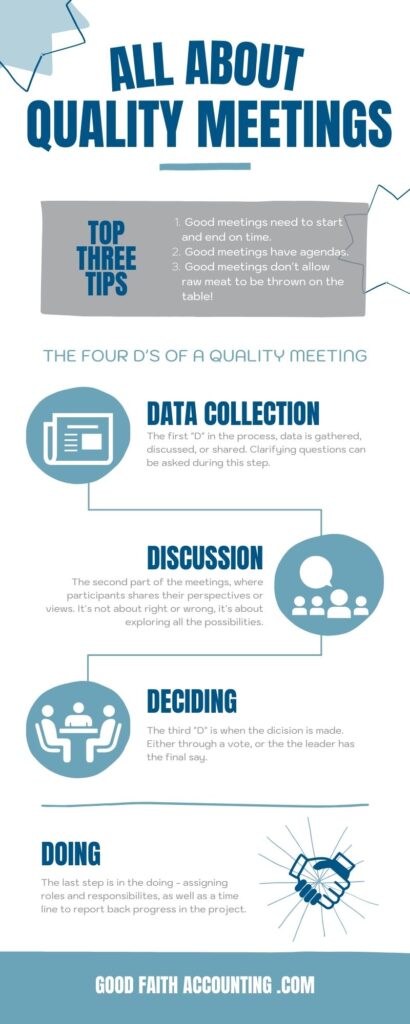August 03, 2021
The 4 D’s of a Quality Meeting
The following is an excerpt from the Training Division of Miller Management.
How to Run a Quality Meeting
Like a quality meal, a quality meeting is composed of many good parts. Meetings, like meals, require planning and careful preparation. The following is an attempt to break down into parts the various aspects of a good meeting. If the component parts of the meeting are communicated well and understood by participants, there is a greater likelihood of your meeting being successful.

Before we discuss the four “D”s, there are a few overarching concepts that should be understood about meetings; and how to make them quality meetings at that.
Good meetings need to start and end on time.
Publish the expected starting and ending times and stay true to the time frame. Generally, any meeting over two hours becomes ineffective. If necessary, draw the meeting to a close and say, “We aren’t finished, but we are going to end this meeting.” Then set a time for another meeting to continue. You might be surprised at how fresh ideas arise when a new meeting to finish up takes place.
Very often, the poorest decisions come late in meetings when everyone is exhausted and tired. Don’t fall prey to this syndrome. Take the necessary time to do it right.
Good meetings have agendas.
Plan, plan, plan, and then be flexible as the need arises. An agenda gives you, the leader, and the participants the opportunity to focus, stay on task, and get more done.
Good meetings don’t allow raw meat to be thrown on the table!
With the exception of an intentional brainstorming session, don’t allow someone to bring up a topic that has not been “pre-cooked” or at least warmed up a bit. Items that are not on the agenda tend to be distracting and often times are meant to be disruptive, divisive, or harmful. If the topic is important enough to bring up at the meeting, then it is important enough to do your homework and get it on the agenda.
It is important for the meeting leader and the participants to have a clear understanding of what is taking place during the meeting. There are four “parts” or processes going on during a meeting.
Remember, communication is not for us, it is for them, so give them what they need!
The Four D’s of a Quality Meeting
These are the four parts to a quality meeting.
1) Data collection
This is a meeting – or a portion of a meeting – where information is being shared, gathered, or discussed for understanding. Here, clarification questions can take place.
It should be understood that this is not the time to debate the merits of the information or the potential decision at hand; we just need to understand the data and make sure we receive its full value.
2) Discussion
This is a meeting – or a portion of a meeting – where we discuss the various aspects of the data presented. What is the data telling us? Do we need more data? Do we need less data? If the information is true, what are the implications?
In this phase, participants only share their perspectives or views; they do not need to spend the time or the energy convincing others that their opinion is “right”. It’s not about right or wrong, it’s about exploring and considering all possibilities so that the eventual decision made is an informed one.
Everyone should be allowed to maintain their opinion, as well as earnestly seek to understand other’s opinions.
3) Deciding
This is a meeting – or a portion of a meeting – where after working through steps 1 and 2 properly, decisions can be made.
Keep in mind voting is acceptable and at times called for, but building a consensus is more valuable (and difficult). Also, not every decision discussed requires a group decision. Sometimes that falls to the leader.
4) Doing
This is a meeting – or portion of a meeting – where after working through the first three steps, it’s time to assign roles and responsibilities. This is the step where folks are assigned tasks and time lines, and teams moves into action mode. Regular and systemic accountability will need to happen to insure things get done.
Using and communicating these steps through one meeting – or a series of meetings – will help participants navigate through difficult processes and hopefully lead to more productive meetings.
In Conclusion
To prepare for your next quality meeting, make sure you are prepared with an agenda and the room is aware of what type of meeting is being held. (Which D is being presented.) Don’t let raw food onto your dinner plate; kindly make time for those items to marinate before going to the dinner table.

Like we mentioned above, if the parts of the meeting are communicated well (and understood!), there is a greater likelihood of your meeting being successful. After all, communication is for them, not us, so give them what they need!
Do you have your own set of rules for meetings? Or will you be adopting the 4 D’s method? Let us know on social media!
Stay Connected